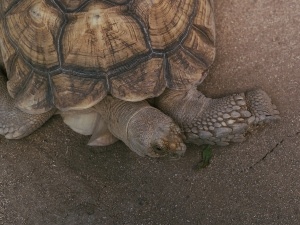
When we say “you’re sticking your neck out” we don’t usually mean literally but when we talk about a turtle sticking its neck out we may mean literally. So why do the animals do this?
This article is a look into why your turtle may be sticking its neck out.
Table of Contents
Why is my turtle sticking his neck out?
Your pet turtle sticking its neck out may be quite funny or it may be quite concerning, none the less, figuring out why your does this is helpful
Here is why your turtle may be sticking its neck out:
Warming up:
One of the instances where a turtle will stick its neck out is while basking. Basking is done by turtles in order to warm their bodies up.
These animals are ectothermic, which means that the temperatures of their bodies are regulated by their environment and not by them producing their own heat like mammals do.
The extending of their necks helps them get more warmth exposed to their skin. The shell doesn’t let much heat penetrate their bodies so extending their necks, and their arms and legs, helps with this.
What to do:
This is perfectly normal behavior and isn’t something that you’d need to worry about, turtles generally do this while basking and it is fairly normal
Begging for food:
If your pet turtle starts swimming frantically and extending its neck when you come around to feed your pet then it’s simply begging for food.
Turtles are opportunistic feeders, they will beg for food even if you’ve already fed them as much food as they need, this is just how they are
What to do:
You don’t have to worry or do anything, this is normal.
Avoid feeding the animal more than necessary if you see this happening, overfeeding the turtle will make it gain too much weight and become fat, which is unhealthy for the animal.
Respiratory infection:
Another reason why the animal is stretching its neck is that the animal is suffering from a respiratory infection.
This condition can be caused by sub-optimal humility, environmental irritants, incorrect temperatures, or infectious agents like viruses, bacteria, parasites, or fungi infecting the animal.
One of the signs of this condition in your pet is an extending the neck while breathing, this is the animal’s way of getting more air into its body.
Other signs of this condition include wheezing, crusted nares, abnormal body posture, open-mouth breathing, gurgling, bubble blowing at the nose or mouth, sneezing, oral or nasal discharge, swimming lopsided, and lethargy.
What to do:
These animals can hide many of their symptoms, they do this on instinct to keep themselves from being targeted by predators in the wild and in captivity.
If you start to see these symptoms in your pet then the animal’s illness may be quite far along. For this reason, taking your pet to a reptile vet is recommended.
The vet will physically examine the animal, take blood tests, and take an x-ray of the animal to evaluate the turtle’s lungs looking for signs of pneumonia.
Treatment for this condition, that your vet may give to your pet, include nebulization treatment and oral or injectable antibiotics
If you enjoyed this article then you may also be interested in other turtle/tortoise related articles. Here are some articles that you may be interested in: Why Is My Turtle Orange?, Why Is My Turtle Extending Its Neck?, Why Is My Turtle Lazy?, Why Is My Turtle Leaning To One Side?, Why Is My Turtle Scratching His Neck?, Why Is My Turtle’s Neck Peeling, Why Is My Turtle’s Neck Red?, Why Is My Turtle On Its Back?, Why Is My Turtle Neck Swollen?

